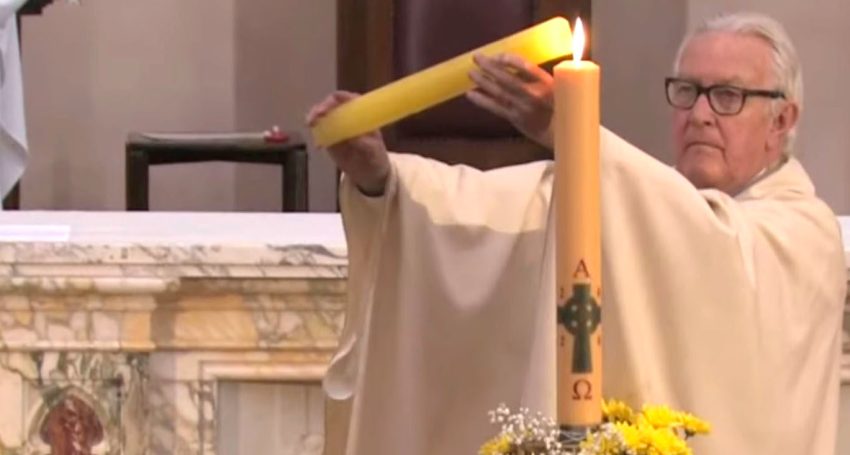Giving thanks for a place in God’s church
People
Fr Anthony Kain celebrated his last Mass as parish priest of Glenelg at the Easter Vigil – to an empty church. Preaching to a camera wasn’t the way he anticipated ending his 12-year mission in the seaside parish but change has been a constant theme throughout his ministry.

Anthony Kain entered the seminary from a faith-filled family in 1962, the same year the Second Vatican council commenced following the surprise announcement by Pope John XXIII in 1959.
In December 1963 the Constitution on the Sacred Liturgy was promulgated, heralding dramatic changes to the way Catholics around the globe practised their faith, including Australia.
“With Archbishop Beovich’s enthusiasm for the Council and the energy of Auxiliary Bishop James Gleeson at his side, we were led on a journey of implementing new approaches to sacramental theology, liturgy and Church among the riches of the Council,” Fr Kain told The Southern Cross.
Advertisement
“Liturgy and the sacramental theology were to become an emphasis for me a few years later.”
Ordained in 1968, Fr Kain and Fr Peter Milburn were appointed assistants to Fr Lou Travers in Mt Gambier where they witnessed the creation of Tenison College. While in the South East, Fr Kain became involved in a Natural Family Planning team.
With the help of his brother Michael, who was a young doctor dealing with the contraceptive pill, the team learnt about the Billings Method which “taught me much about lay women and lay men and the ordinated in relational ministry which I brought to ministry tasks for the next 50 years”.
As an assistant priest in Brighton during the 1970s, he saw Maureen O’Shaunessy become the first lay woman pastoral associate. Parish pastoral teams were formed with lay women, religious and priests collaborating with one another.
“This has been one of the early and continuing treasures of my years as a priest,” he said.
Fr Kain was appointed parish priest of Mt Barker in 1978 and was surprised when Archbishop Gleeson asked him to study liturgy.
“I found myself in Washington DC at the Catholic University of America where I had the good fortune to sit at the feet of theologians who had been ‘periti’ (theological advisors) to the Vatican Council,” he recalled.
“Having obtained my Masters in Liturgy Studies I then had the good fortune to study at the Institute for Liturgy in Paris where again I was taught by periti.
“I came back to Mt Barker and had a double life of pastoral ministry in the parishes I served with Josephite Sisters and teaching liturgy at workshops around the parishes and courses in the Theology Institute that Denis Edwards (deceased) had founded.”
Fr Kain said it was “a real grace” that Fr Edwards was doing his doctorate when he was doing his MA at the Catholic University of America.
Later Fr Kain became a lecturer at the ecumenical Adelaide College of Divinity and for a couple of years he lectured at the Australian Catholic University.
In 1986 he was asked to be the SA state director of the Papal Visit which he described as a great experience, taking him to all parishes and migrant communities for the preparations.
Advertisement
“This was the time for creating structures that served the implementation of the Council.”
In the early 1990s he asked for some study leave for a few months and to his surprise the Jordan Kennedy Scholarship Committee asked him to consider study more seriously so he found himself enrolled in the Doctor of Ministry Program at the Catholic Theological College in Chicago.
“Living in a very multicultural country, communication in such a diverse culture intrigued me so my topic was ‘Companions of Variable Mindfulness: Ministry in a Multicultural Society and Church’,” he said.
“That sounds a bit pretentious yet this study served me well; I became parish priest of Woodville/Findon when the ‘boat people’ were coming to Adelaide.
“Woodville already had an Italian Mass each Sunday and we started a Vietnamese Mass too.
“My Italian was not to bad but my Vietnamese leaves room for improvement. Thank God they were polite; one day I said in Vietnamese ‘let us offer each other a sign of peace’ – the teenagers were delighted and grinned, the women were embarrassed and the men looked down at their shoes.
“I asked the teenagers what I had said but they just grinned and said ‘it is too rude, Father, too rude’.
“I break into English for the sign of peace to this day with the Vietnamese!”
For many years Fr Kain has been a member of clergy fraternities and Teams of Our Lady.
Other highlights of his ministry included founding the Australian Academy of Liturgy with Mercy Sister Mary-Anne Duigan in 1980 and his involvement with the Office for Worship (as director) and the Diocesan Liturgy Commission.
As for the past weeks of coronavirus restrictions, Fr Kain said streaming Holy Week and the Sunday Mass was summed up for him in the phrase ‘present but not seen’.
“Years ago when I came to a new parish I was praying in the empty parish church and I had a sense of all the people who had lived in that parish over the years,” he said.
“That sense came to me when we had the 140th anniversary the first year I was in Glenelg – 1969.
“The empty pews are a symbol of the people who sat in them, present to Word and Sacrament, to Jesus and the Spirit and the Creator, Sunday after Sunday, year after year.
“And the people who are ill, suffering, dying, grieving, distressed by the effects of virus, they draw us into the mystery of Easter and listen to Jesus who assures us ‘there are many rooms in my Father’s House…I am going now to prepare a place for you’.
“Thanks for having a place for me in your church. God bless you all.”








Comments
Show comments Hide comments